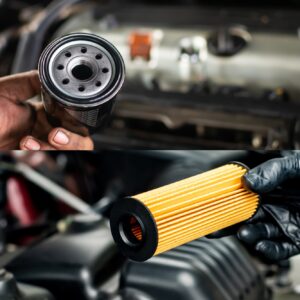When doing an oil change, you’ll also need to replace your vehicle’s oil filter aside from replacing the oil. The oil filter can vary depending on the make and model. Some vehicles have cartridge filters, which look similar to cold air filters and are screwed onto a filter head on the engine. Other vehicles have spin-on filters. These oil filters are screwed onto a filter head underneath the engine. Removing spin-on filters typically requires a special oil filter wrench, but is it really necessary?
What’s an Oil Filter Wrench?
Oil filter wrenches are special tools that can grip a slippery aluminum spin-on oil filter and remove it. The task of removing a spin-on oil filter might be as simple as removing a sealed jar, but sometimes the filter will be so tight that removing it can be very difficult without the right tool. Some cheap filters may have a gasket that swells over time, making the filter hard to remove even if it wasn’t over-tightened on installation.

Some cheap filters may have a gasket that swells over time, making the filter hard to remove even if it wasn’t over-tightened on installation.
– Richard McCuistian, ASE Certified Master Automobile Technician
Because spin-on oil filters come in many sizes depending on the vehicle model, many oil filter wrenches are designed to accommodate different filter sizes. The strap or pliers-style oil wrenches typically require more space under the hood around the filter.
Traditional or strap oil filter wrenches have a long lever with a rubber strip that’s designed to wrap around the oil filter and sometimes the strap handle is on a swivel. Some variants use a metal chain instead of a rubber strip to grip the slippery twist-on oil filter.
There are also socket or end-cap wrenches that are attached to ratchet wrenches but this type is size-specific and there are entire sets of these with cap wrenches that fit a variety of sizes. Some aftermarket oil filters have a hex or square lug at the bottom that allows conventional wrenches or sockets to be used.
Regardless of the design, most oil filter wrenches are designed to provide a secure grip on the spin-on filter and provide a lever so that you can unscrew the filter more easily. You should take note that not all oil filters can be perfect for your oil filter. That said, traditional oil filter wrenches are quite versatile. Nevertheless, oil filter wrenches might be a specialized tool but they’re quite easy to get and affordable.
How to Take Off Oil Filter Without a Wrench
You might be wondering “do I need an oil filter wrench to remove my vehicle’s oil filter?” Technically, no. Unless a filter is in a very difficult place or is over-torqued, you can usually remove it by hand.
Using Your Hands
You can simply grip the oil filter and unscrew it from your engine. You just need good gloves, a good grip and a lot of elbow grease.
Unscrewing the oil filter can be difficult because the can is quite smooth, and that can make it difficult to grip. Since the oil filter is often underneath the vehicle, it can also be hard to find the leverage to do so. Take note that if the engine is hot, the oil filter and the oil inside it will be too, so let your engine cool first before removing the oil filter.

Using a Straight Pipe Wrench
If you have a large enough straight pipe wrench at home, you can probably use it to remove an oil filter. It works much like a specialist oil filter wrench in that it can grip the oil filter and give you more leverage.
Note, however, that sometimes a pipe wrench will crush the filter shell and begin to slip, especially if the shell is breached by the teeth on the pipe wrench, then you’ll have a mess. If you decide to try a pipe wrench, tighten the wrench’s adjustable jaw around the oil filter, make sure that the wrench is secure, and start unscrewing it. Looking at the end of the filter, turn it counter-clockwise.
Puncturing the Oil Filter With a Screwdriver
In extreme cases where you can’t get it off by hand and a filter wrench won’t fit or won’t work, you might be able to drive a screwdriver all the way through the filter from one side to the other with a hammer about halfway up the side of the filter, then push it in a counter-clockwise direction to unscrew the oil filter.
Remember that oil will always spill out when removing a spin-on filter, so you should have an oil pan underneath to catch the oil. Make sure to wear protective gear like gloves or eye protection so that you don’t get engine oil on your body.
Overall, removing oil filters is a relatively simple process. As previously mentioned, it’s just like removing the lid of an upside-down jar. Oil filter wrenches might be inexpensive tools, but just know that there are other ways to remove an oil filter without a specialized oil filter wrench.
Keep Track of the Old Gasket
After removing the filter, make sure you know where the gasket is. If it sticks to the filter head and you install the new filter without removing the old stuck gasket, you can, at best, make a big mess, and at worst, destroy the engine.

How to Get Your Hands on a New Oil Filter
Vehicles typically need an oil change once every six months. During each session, most mechanics recommend removing the old oil filter and replacing it with a new one. Luckily, CarParts.com makes shopping online for a new oil filter easy and hassle-free.
Get the best bang for your buck by choosing an oil filter manufactured by some of the most trusted brands in the industry. All products in our catalog are also vetted by a team of automotive professionals who ensure our high quality standards are met.
Start shopping by downloading our mobile app or visiting our website. Place your order online and expect your new oil filter to arrive at your doorstep in as fast as two business days.
Don’t hold off on getting a new oil filter so you can carry out your oil change. Order a replacement from CarParts.com today!
Any information provided on this Website is for informational purposes only and is not intended to replace consultation with a professional mechanic. The accuracy and timeliness of the information may change from the time of publication.































